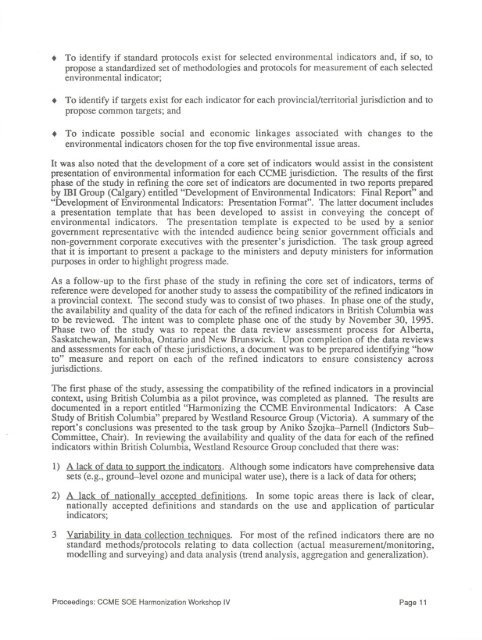CCME State of the Environment Reporting Harmonization Workshop ...
CCME State of the Environment Reporting Harmonization Workshop ...
CCME State of the Environment Reporting Harmonization Workshop ...
You also want an ePaper? Increase the reach of your titles
YUMPU automatically turns print PDFs into web optimized ePapers that Google loves.
. To identify if standard protocols exist for selected environmental indicators and, if so, to<br />
propose a standardized set <strong>of</strong> methodologies and protocols for measurement <strong>of</strong> each selected<br />
environmental indicator;<br />
. To identify if targets exist for each indicator for each provincial/territorial jurisdiction and to<br />
propose common targets; and<br />
. To indicate possible social and economic linkages associated with changes to <strong>the</strong><br />
environmental indicators chosen for <strong>the</strong> top five environmental issue areas.<br />
It was also noted that <strong>the</strong> development <strong>of</strong> a core set <strong>of</strong> indicators would assist in <strong>the</strong> consistent<br />
presentation <strong>of</strong> environmental information for each <strong>CCME</strong> jurisdiction. The results <strong>of</strong> <strong>the</strong> first<br />
phase <strong>of</strong> <strong>the</strong> study in refining <strong>the</strong> core set <strong>of</strong> indicators are documented in two reports prepared<br />
by mI Group (Calgary) entitled "Development <strong>of</strong> <strong>Environment</strong>al Indicators: Final Report" and<br />
"Development <strong>of</strong> <strong>Environment</strong>al Indicators: Presentation Format". The latter document includes<br />
a presentation template that has been developed to assist in conveying <strong>the</strong> concept <strong>of</strong><br />
environmental indicators. The presentation template is expected to be used by a senior<br />
government representative with <strong>the</strong> intended audience being senior government <strong>of</strong>ficials and<br />
non-government corporate executives with <strong>the</strong> presenter's jurisdiction. The task group agreed<br />
that it is important to present a package to <strong>the</strong> ministers and deputy ministers for information<br />
purposes in order to highlight progress made.<br />
As a follow-up to <strong>the</strong> first phase <strong>of</strong> <strong>the</strong> study in refining <strong>the</strong> core set <strong>of</strong> indicators, terms <strong>of</strong><br />
reference were developed for ano<strong>the</strong>r study to assess <strong>the</strong> compatibility <strong>of</strong> <strong>the</strong> refined indicators in<br />
a provincial context. The second study was to consist <strong>of</strong> two phases. In phase one <strong>of</strong> <strong>the</strong> study,<br />
<strong>the</strong> availability and quality <strong>of</strong> <strong>the</strong> data for each <strong>of</strong> <strong>the</strong> refined indicators in British Columbia was<br />
to be reviewed The intent was to complete phase one <strong>of</strong> <strong>the</strong> study by November 30, 1995.<br />
Phase two <strong>of</strong> <strong>the</strong> study was to repeat <strong>the</strong> data review assessment process for Alberta,<br />
Saskatchewan, Manitoba, Ontario and New Brunswick. Upon completion <strong>of</strong> <strong>the</strong> data reviews<br />
and assessments for each <strong>of</strong> <strong>the</strong>se jurisdictions, a document was to be prepared identifying "how<br />
to" measure and report on each <strong>of</strong> <strong>the</strong> refined indicators to ensure consistency across<br />
jurisdictions.<br />
The first phase <strong>of</strong> <strong>the</strong> study, assessing <strong>the</strong> compatibility <strong>of</strong> <strong>the</strong> refined indicators in a provincial<br />
context, using British Columbia as a pilot province, was completed as planned The results are<br />
documented in a report entitled "Harmonizing <strong>the</strong> <strong>CCME</strong> <strong>Environment</strong>al Indicators: A Case<br />
Study <strong>of</strong> British Columbia" prepared by Westland Resource Group (Victoria). A summary <strong>of</strong> <strong>the</strong><br />
report's conclusions was presented to <strong>the</strong> task group by Aniko Szojka-Pamell (Indictors Sub-<br />
Committee, Chair). In reviewing <strong>the</strong> availability and quality <strong>of</strong> <strong>the</strong> data for each <strong>of</strong> <strong>the</strong> refined<br />
indicators within British Columbia, Westland Resource Group concluded that <strong>the</strong>re was:<br />
1) A lack <strong>of</strong> data to sUP1>rt <strong>the</strong> indicators. Although some indicators have comprehensive data<br />
sets (e.g., ground-level ozone and municipal water use), <strong>the</strong>re is a lack <strong>of</strong> data for o<strong>the</strong>rs;<br />
2) A lack <strong>of</strong> nationally accepted definitions. In some topic areas <strong>the</strong>re is lack <strong>of</strong> clear,<br />
nationally accepted definitions and standards on <strong>the</strong> use and application <strong>of</strong> particular<br />
indicators;<br />
3 Variability in data collection techniques. For most <strong>of</strong> <strong>the</strong> refined indicators <strong>the</strong>re are no<br />
standard methods/protocols relating to data collection (actual measurement/monitoring,<br />
modelling and surveying) and data analysis (trend analysis, aggregation and generalization).<br />
Proceedings: <strong>CCME</strong> SOE <strong>Harmonization</strong> <strong>Workshop</strong> IV Page 11
















